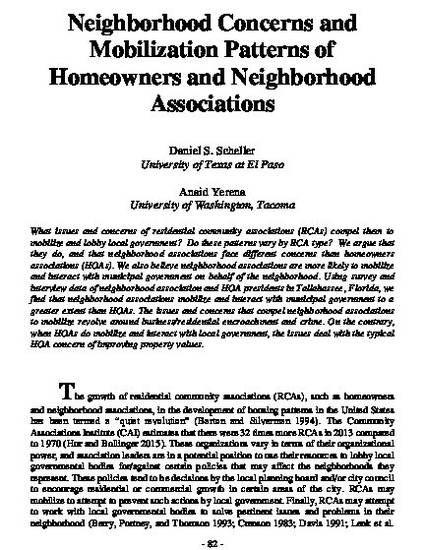Abstract
What issues and concerns of residential community associations (RCAs) compel them to mobilize and lobby local government? Do these patterns vary by RCA type? We argue that they do, and that neighborhood associations face different concerns than homeowners associations (HOAs). We also believe neighborhood associations are more likely to mobilize and interact with municipal government on behalf of the neighborhood. Using survey and interview data of neighborhood association and HOA presidents in Tallahassee, Florida, we find that neighborhood associations mobilize and interact with municipal government to a greater extent than HOAs. The issues and concerns that compel neighborhood associations to mobilize revolve around business/residential encroachment and crime. On the contrary, when HOAs do mobilize and interact with local government, the issues deal with the typical HOA concern of improving property values.
Citation Information
Daniel S Scheller and Anaid Yerena. "Neighborhood Concerns and Mobilization Patterns of Homeowners and Neighborhood Associations" p. The growth of residential community associations (RCAs), such as homeowners and neighborhood associations, in the development of housing patterns in the United States has been termed a “quiet revolution” (Barton and Silverman 1994). The Community Associations Institute (CAI) estimates that there were 32 times more RCAs in 2013 compared to 1970 (Hur and Bollinger 2015). These organizations vary in terms of their organizational power, and association leaders are in a potential position to use their resources to lobby local governmental bodies for/against certain policies that may affect the neighborhoods they represent. These policies tend to be decisions by the local planning board and/or city council to encourage residential or commercial growth in certain areas of the city. RCAs may mobilize to attempt to prevent such actions by local government. Finally, RCAs may attempt to work with local governmental bodies to solve pertinent issues and problems in their neighborhood (Berry, Portney, and Thomson 1993; Crenson 1983; Davis 1991; Lenk et al. 2002) or to engage in the coproduction of goods and services (Lelieveldt et al. 2009). They are fundamental actors in neighborhood mobilization and development (Crew, Kim, and Schweitzer 1999; Rich 1980). The two most common RCAs are neighborhood and homeowners associations (HOAs). How do these RCAs vary in terms of their neighborhood issues and concerns, and how and for what issues/concerns do RCAs mobilize?
Available at: http://works.bepress.com/anaid_yerena/31/

